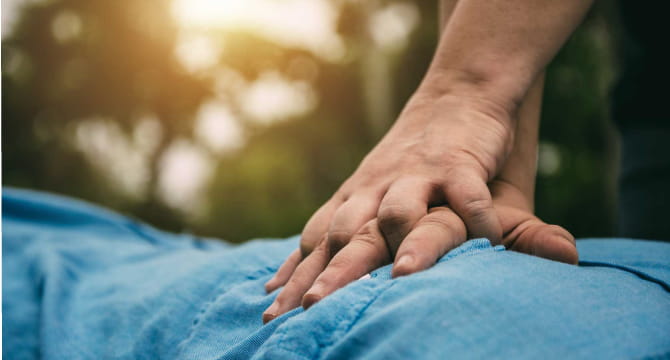CPR is key to survival of sudden cardiac arrest
By American Heart Association News

CPR increases the possibility of surviving sudden cardiac arrest. But it's not just trained professionals who can jump in to perform CPR. There are simple, lifesaving steps any bystander can take.
“We think it should be a basic life skill,” such as knowing to call 911 when there’s a fire, said Dr. Clifton Callaway, a professor and executive vice chair of emergency medicine at the University of Pittsburgh.
He gives this simple guidance: If someone is unconscious and does not appear to be breathing properly, it’s time to start CPR chest compressions.
Cardiac arrest is when the heart stops beating. Some 350,000 cases occur each year outside of a hospital, and the survival rate is less than 12 percent. CPR can double or triple the chances of survival.
Seventy-percent of cardiac arrests happen in homes, but for those that happen in a workplace, a recent American Heart Association survey found that most U.S. employees are not prepared for a cardiac emergency.
For years, performing CPR meant checking the airway and doing mouth-to-mouth resuscitation in addition to chest compressions. Experts now advise chest compressions alone can keep the heart pumping and maintain blood flow for a few minutes until emergency workers arrive.
Hands-only CPR is part of an effort to get more people to take action. The steps are: Call 911 and immediately begin chest compressions when someone is unconscious and having difficulty breathing. If you need guidance, an emergency operator can explain what to do. Using a cell phone, it may be possible to perform CPR and speak with the 911 dispatcher at the same time.
Compression-only CPR is best suited for adults and teens. You should press hard and fast in the center of the chest, down at least 2 inches with the full weight of your body.
“In general, people don’t push hard enough because they’re afraid,” Callaway said. But “you’re pumping blood. You’re replacing the heart beat.”
The optimum rate of compression is 100 to 120 beats per minute. It may come naturally, but if you need help gauging it, thinking of a song may help.
“Stayin’ Alive,” by the Bee Gees is the right tempo. “Girls Just Want To Have Fun” by Cyndi Lauper or “Should I Stay or Should I Go?” by the Clash also are in the 100 to 120 beats-per-minute range.
Learning conventional CPR is more involved. It includes compressions and mouth-to-mouth breaths. and is taught in person at training centers or online.
In fact, it’s more appropriate for children than hands-only CPR because they often suffer breathing difficulties connected to drowning or choking. That’s why those who spend time around children, such as teachers or coaches or people who have children, are urged to learn it, Callaway said.
There are three main reasons someone may be hesitant to perform CPR, said Callaway, a volunteer on the AHA's Emergency Cardiovascular Care Committee:
- Not recognizing CPR is needed. If a person is unconscious and breathing abnormally, even if it’s a suspected drug overdose, begin CPR.
- You’re not trained and you worry you might hurt the person. But it’s better to help than do nothing. Don’t be afraid to apply pressure.
- For family members, assisting in an emergency is stressful. Some people report they “freaked out,” Callaway said. But a 911 dispatcher can help refocus and get you going.
With AEDs, or automated external defibrillators, increasingly common in public places, one may be available during a cardiac arrest. So, because chest compressions should begin right away, it’s best to have two responders – one to do chest compressions and the other to set up and use the AED.
Technology is contributing in other ways, too.
In some cities, volunteers who know CPR, such as doctors or off-duty medics or police officers, are signing up to be paged via a mobile app if someone is suffering cardiac arrest nearby.
But anyone can – and should – perform CPR, Callaway said. "Doing something is the right thing to do. It can only help.”
If you have questions or comments about this story, please email [email protected].




